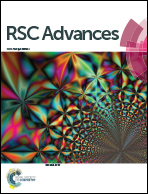Synthesis of dimethyl carbonate (DMC) based biodegradable nitrogen mustard ionic carbonate (NMIC) nanoparticles†
Abstract
Chitosan-nitrogen mustard ionic carbonate nanoparticles (C-NMIC-Nps) were fabricated for the first time by an ionotropic gelation method. The preparation of C-NMIC-Nps involved four steps. In the first step, green reagent dimethyl carbonate (DMC) reacted with 2-dimethylethanolamine (DMEA) to form bis-(2-dimethyl amino-ethyl)carbonate (DAEC). In the second step, DAEC underwent cationization with (1-chloro-2,3 epoxy)propane to form NMIC with a stable carbonate backbone having a greater number of sorption sites. Later, NMIC was successfully cross linked with chitosan to form C-NMIC, which was later on used to form C-NMIC nanoparticles (C-NMIC-Nps) by ionotropic gelation. The chemical structure of NMIC and C-NMIC was identified by proton nuclear magnetic resonance (1H-NMR), 13C nuclear magnetic resonance (13C-NMR) spectroscopy and elemental analysis. The spherical shaped, smooth and uniform distribution of the C-NMIC-Nps was observed by scanning electron microscopy (SEM) and high resolution transmission electron microscopy (HRTEM). The average particle size distribution of the C-NMIC-Nps was found to be 14.4 ± 3.1 nm as observed using a particle size analyzer. The functional groups of DAEC, NMIC and C-NMIC were identified by Fourier transform infrared spectroscopy (FTIR). The conversion of the crystalline nature of chitosan to the amorphous state in C-NMIC-Nps was studied by X-ray diffraction (XRD). The thermal stability of the C-NMIC-Nps was confirmed by thermo gravimetric analysis (TGA). The good cell viability of C-NMIC-Nps was assessed by in vitro MTT assay using VERO cell lines. Overall, the results suggested that C-NMIC-Nps had been prepared successfully. The prepared C-NMIC-Nps will act as a nano carrier of growth factors for wound healing application.


 Please wait while we load your content...
Please wait while we load your content...